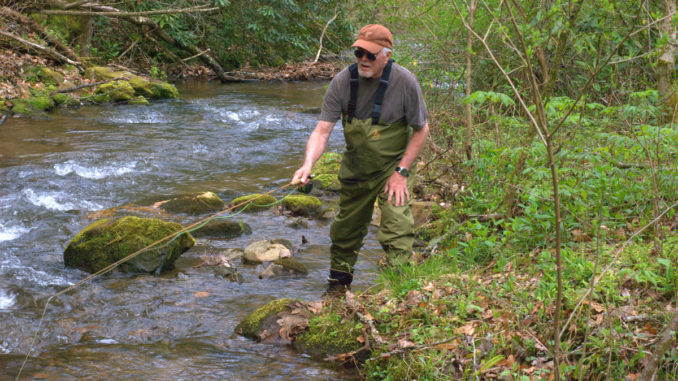
Go to higher elevations for more-active fish
Late-summer trout fishing requires a slow hand, patience and endurance. Hatches are fewer, and as water temperatures rise, trout seek cooler places in streams: undercut or overgrown banks and deep pools. When water levels drop, as they often do in August, trout are easily spooked.
Walter Parrott, manager of guide services for Davidson River Outfitters in Brevard, suggests getting an early start. For best results, he said, “Start fishing a low-light, around 6 a.m., and use long leaders (at least 9 feet) and 5X or 6X tippets.”
Low, clear water makes trout extremely spooky, especially the wild ones. Keep a low profile and fish upstream so that trout are less likely to see you coming. If you see fish darting when you move in the water, forget about that particular stretch and move on to the next stretch.
“Fish the long slicks and the ripples and under bushes,” Parrott said. “When the sun gets on the water, stay with the ripples and fast-moving water where oxygen is more plentiful.”
Keep tabs on water temperatures. When water heats up to the high 60s, trout seldom feed. Ideal summer water temperature should be in the mid- to high 50s, a temperature range usually found only in high-elevation streams that have abundant cover. The trout will be smaller, but the quality of fishing will be much better than the fishing in lower-elevation streams.
Parrott said since hatches are limited, go with terrestrials.
“Trout will feed on any kind of bug you find in the yard, especially ants, beetles, crickets, grasshoppers and inchworms.
“You will see a few hatches such as the Yellow Sally, Cahills and Caddis,” Parrott said, but the main summer food for trout is a terrestrial.
Nymph patterns can be fished all day, but they require more skill and patience than dry flies. Strikes can be very subtle and difficult to detect unless you’ve done a lot of nymph fishing. Sometimes, a strike will be little more than a slight hesitation of the leader.
If your nymph fishing is limited, use a commercial strike indicator and attach it to the leader 2 to 3 feet above the fly. A piece of yarn or cotton attached to the leader works as well as a commercial strike indicator. Watch the indicator as it floats. If it hesitates or moves to one side or the other, raise your rod tip. You’ve likely had a strike.
Dry flies also make excellent strike indicators, and they give you an extra edge in the water. Sometimes, a trout will hit the dry fly instead of the nymph. When using a dry fly as a strike indicator, use a section of leader and tie the nymph onto the shank of the main hook and use the nymph as a dropper. If the stream is shallow, the dropper should hang about 6 inches below the dry fly — 12 inches for deeper water. The nymph should be small enough that it doesn’t drag the dry fly down. If you’re using a No. 14 or 16 nymph, for example, use a No. 12 or larger dry fly. A yellow Stimulator or other attractor pattern makes an excellent strike indicator.
Thunderstorms are a natural part of summer in the mountains. Usually, though, they come in fast and end quickly. If you hear thunder, move off the stream. Water is no place to be when lightning is flashing. Also, water levels can rise to dangerous levels very quickly.
After the storm has passed, water will be dingy for a short time, especially on high-gradient streams. This is the ideal time to switch to streamers: Woolly Buggers, Muddler Minnow, Sculpin, Dace and other patterns imitate swimming aquatic life. Streamers also work very well in deep pools, places where big brown trout are more likely to be. Strip them through the water or let them float in a current. Strikes are less frequent on streamers, but when you get a strike, it’s usually a big fish.
Shane Buckner, manager of Hunter Banks fly shop in Asheville, suggests fishing the remote, wild-trout streams, particularly those in the Great Smoky Mountains National Park, where rainfall is more abundant in the summer, and the remote streams in the national forests and along the Blue Ridge Parkway. Many of these streams require hiking a couple of miles or so, but the payoff is better fishing and less competition.
For backcountry fishing, Buckner says he has switched to the Tenkara style of fishing, a fixed-line form of fly fishing that originated in Japan more than three centuries ago.
“It simplifies fly fishing,” Buckner said.
The rods do not have reels or spools. Instead, the fly line is attached to the end of the rod, and the telescopic rod can be stretched to three length levels.
“Instead of the traditional method of fly-casting — back to 2 o’clock, forward to 10 — the Tenkara cast is 10 to 12,” Buckner said.
One model of Tenkara rod that Buckner’s shop sells is the triple-zoom Rhodo, which comes in lengths of 8-foot-10, 9-foot-9 and 10-foot-6.
“This rod works especially well on small streams,” he said, “You can bow-and-arrow the fly under bushes and places you normally couldn’t fish with a traditional fly rod.”
A second version of the Tenkara is the Sato which zooms to lengths of 10-foot-8, 11-foot-10 and 12-foot-9.
“When I go fishing with a Tenkara rod, the only equipment I carry are flies, forceps, fly dressing and tippet material,” he said.
The big plus is that the telescopic Tenkara rods are much easier to carry when hiking to back-country streams.
Trout fishing is a year-round activity. All you have to do is adapt to the weather and the fishing conditions.

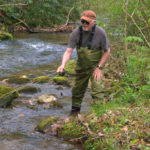
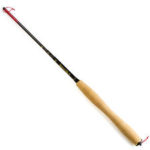
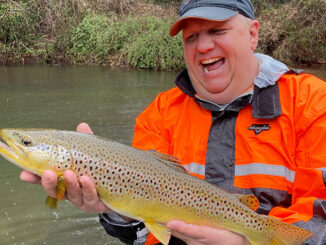

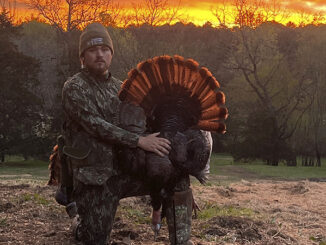

Be the first to comment